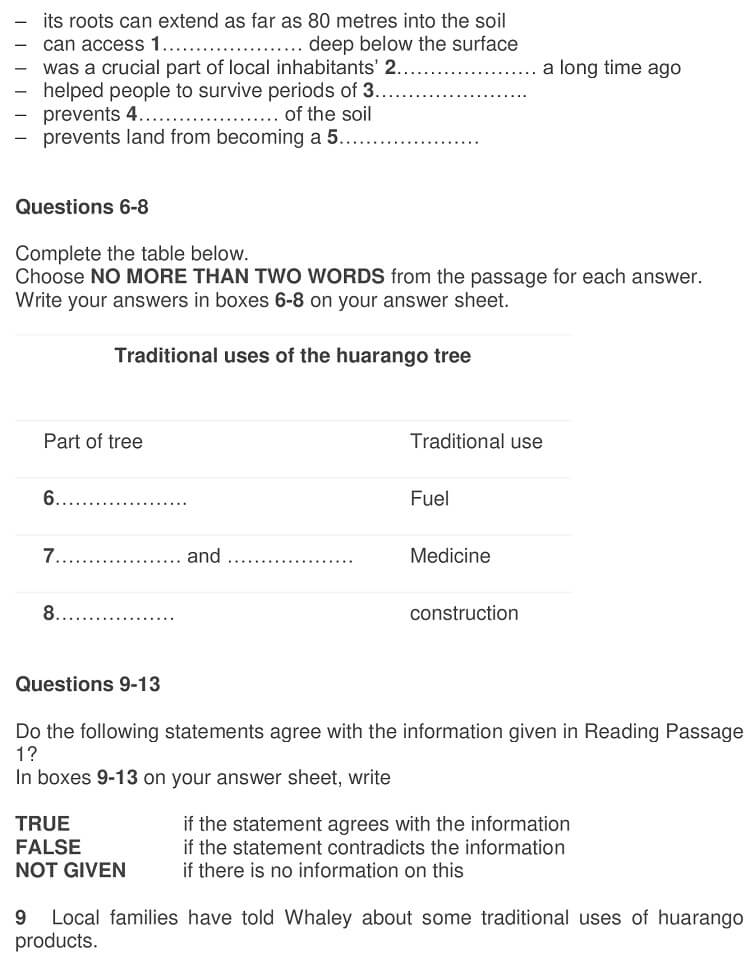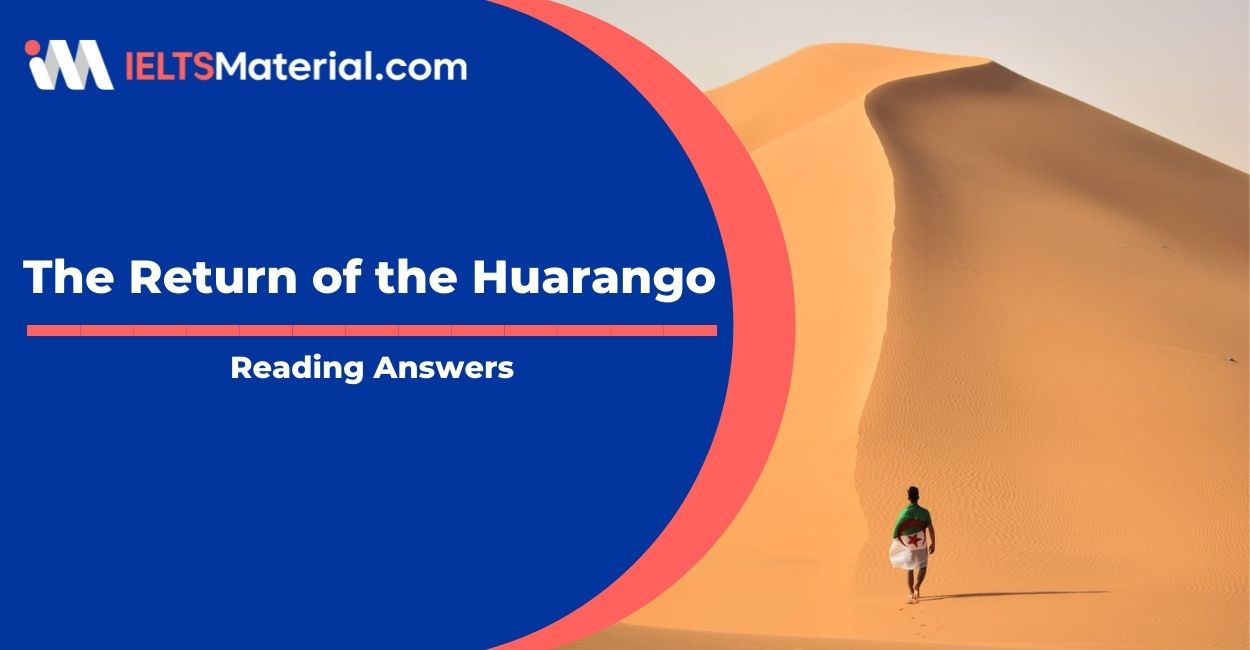The Return of the Huarango IELTS Reading Answers
7 min read
Updated On
-
Copy link
Table of Contents

Limited-Time Offer : Access a FREE 10-Day IELTS Study Plan!
The Academic passage ‘The Return of the Huarango’ is a reading passage that appeared in an IELTS Test. It contains some of the IELTS reading question types. If you are interested in familiarising yourself with all the question types, don’t hesitate to take an IELTS reading practice test.
The question types found in this passage are:
Note Completion:
In Note Completion questions, you are required to complete the notes by following the passage. You have to locate the keywords from the passage, correlate the questions, and fill the gap with the most suitable answer. Questions could be paraphrased and not necessarily taken from the passage. You must also follow the word limit strictly.
Table Completion:
In Table Completion, you are required to complete the table by following the passage. You have to locate the keywords from the passage, correlate the table’s content with the passage, and fill the gap with the most suitable answer following the word limit mentioned in the question. Questions could be paraphrased and they would not be necessarily taken from the passage.
True/False/Not Given:
In True/False/Not Given, you are required to give an answer using ‘True’, ‘False’, or ‘Not Given’ with respect to the statements made. If you believe that the given statement is mentioned in the text and is valid, write ‘True’. If you think the statement is wrong, write ‘False’. And, in case you do not find any piece of information regarding the given statement, write ‘Not Given’.
The return of the Huarango
The arid valleys of southern Peru are welcoming the return of a native plant.




Answers
1 Answer: water
Question Type: Note Completion
Answer location: Paragraph 1, Lines 6-8
Answer explanation: “They stretch down 50-80 metres and, as well as sucking up water for the tree, they bring it into the higher subsoil, creating a water source for other plant life.” This shows that Huarango tree (they) is capable of sucking up (access) water by stretching down 50-80 metres (deep below the soil).
2 Answer: diet
Question Type: Note Completion
Answer location: Paragraph 2, Lines 3-6
Answer explanation: “He believes the huarango was key to the ancient people’s diet and, because it could reach deep water sources, it allowed local people to withstand years of drought when their other crops failed.” This line suggests that the Huarango tree must have been a crucial (key) part of diet for the ancient (a long time ago) people (local inhabitants) as its deep roots helped the tree to survive drought by collecting ground water efficiently.
3 Answer: drought
Question Type: Note Completion
Answer location: Paragraph 2, Lines 3-7
Answer explanation: “He believes the huarango was key to the ancient people’s diet and, because it could reach deep water sources, it allowed local people to withstand years of drought when their other crops failed.” This line suggests that the Huarango tree must have helped the ancient people as its deep roots helped the tree to collect ground water efficiently and survive (withstand) periods (years) of drought.
4 Answer: erosion
Question Type: Note Completion
Answer location: Paragraph 2, Lines 6-8
Answer explanation: “But over the centuries huarango trees were gradually replaced with crops. Cutting down native woodland leads to erosion, as there is nothing to keep the soil in place.” These lines points out that replacing the Huarango tree caused soil erosion as the crop fields that were used as a replacement couldn’t hold the soil. Hence, the answer is ‘erosion’ as the Huarango trees used to keep the soil in place (prevented erosion).
5 Answer: desert
Question Type: Note Completion
Answer location: Paragraph 2, Lines 8-9
Answer explanation: “So when the huarangos go, the land turns into a desert. Nothing grows at all in the Lower Ica Valley now.” This shows that extirpating Huarango trees causes the land to turn into a desert. It proves that these trees prevented the land from becoming a desert.
6 Answer: huarango branches /the branches/ its branches
Question Type: Table Completion
Answer location: Paragraph 3, Lines 3-5
Answer explanation: “Its leaves and bark were used for herbal remedies, while its branches were used for charcoal for cooking and heating, and its trunk was used to build houses.” This suggests that the branches of the Huarango trees were used as fuel (charcoal for cooking and heating).
7 Answer: bark, leaves
Question Type: Table Completion
Answer location: Paragraph 3, Lines 3-5
Answer explanation: “Its leaves and bark were used for herbal remedies, while its branches were used for charcoal for cooking and heating, and its trunk was used to build houses.” From this sentence, it is suggested that the bark and leaves of the Huarango trees were used as herbal remedies (medicines).
8 Answer: huarango trunk/ the trunk/ its trunk
Question Type: Table Completion
Answer location: Paragraph 3, Lines 3-5
Answer explanation: “Its leaves and bark were used for herbal remedies, while its branches were used for charcoal for cooking and heating, and its trunk was used to build houses.” This suggests that the trunk of the Huarango trees were used to build houses (construction).
9 Answer: Not Given
Question Type: True/False/Not Given
Answer location: N/A
Answer explanation: There is no reference as such local families have told Whaley about some traditional uses of huarango products.
10 Answer: False
Question Type: True/False/Not Given
Answer location: Paragraph 6, Lines 1-6
Answer explanation: “Alberto Benevides, owner of Ica Valley’s only certified organic farm, which Whaley helped set up, has been planting the tree for 13 years. He produces syrup and flour, and sells these products at an organic farmers’ market in Lima. His farm is relatively small and doesn’t yet provide him with enough to live on, but he hopes this will change.” This suggests that Alberto is not making much profit from his farm that grows Huarango yet.
11 Answer: True
Question Type: True/False/Not Given
Answer location: Paragraph 7, Lines 1-6
Answer explanation: “But even if Whaley can convince the local people to fall in love with the huarango again, there is still the threat of the larger farms. Some of these cut across the forests and break up the corridors that allow the essential movement of mammals, birds and pollen up and down the narrow forest strip. In the hope of counteracting this, he’s persuading farmers to let him plant forest corridors on their land.” This suggests that Whaley needs the cooperation of the local people and farmers by persuading them to protect the area for wildlife.
12 Answer: False
Question Type: True/False/Not Given
Answer location: Paragraph 8, Lines 3-6
Answer explanation: “‘It’s not like a rainforest that needs to have this huge expanse. Life has always been confined to corridors and islands here. If you just have a few trees left, the population can grow up quickly because it’s used to exploiting water when it arrives.’ This implies that Walley doesn’t need a huge area like a rainforest in order to make his project successful. Instead, he states that a small patch of land (confined corridors and islands) would serve the purpose.
13 Answer: Not Given
Question Type: True/False/Not Given
Answer location: N/A
Answer explanation: Although there is a reference that Africa and similar arid regions of the world may benefit from this project, there is no reference that Waley has any plans to set up or initiate it in Africa.
Check More IELTS Reading Answers
Practice IELTS Reading based on question types

Start Preparing for IELTS: Get Your 10-Day Study Plan Today!
Recent Articles

Nehasri Ravishenbagam

Haniya Yashfeen

Haniya Yashfeen

Haniya Yashfeen




Post your Comments